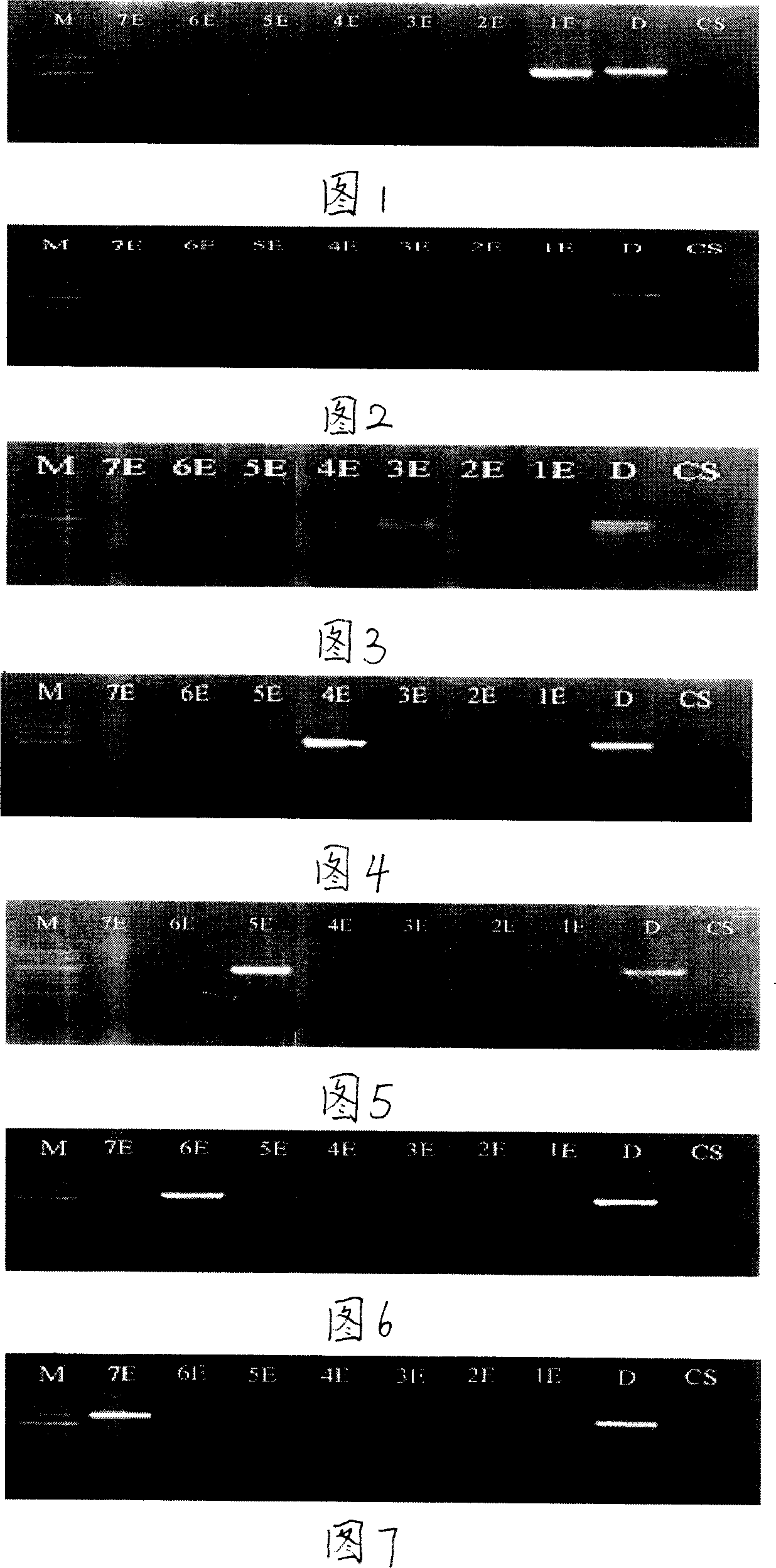Long spike twitch-grass E chromosomal RGA SCAR specific molecular label and application thereof
A technology of wheat grass and molecular marker, which is applied in the fields of biological genetic engineering technology and genetic breeding
- Summary
- Abstract
- Description
- Claims
- Application Information
AI Technical Summary
Problems solved by technology
Method used
Image
Examples
Embodiment 1
[0158] 1. Genomic DNA extraction
[0159] Genomic DNA was extracted by CTAB method. Take 2g of fresh young leaves, grind them into fine powder with liquid nitrogen, add 2×CTAB extract (2% CTAB, 1.4M NaCl, 0.1 MTris-HCl (pH8.0), 0.1M EDTA (pH8.0) preheated to 65°C .0), add 15ml of 2% β-mercaptoethanol before use, and mix well.
[0160] 65 ℃ water bath for 30-45min, during which gently shake to mix.
[0161] After cooling to room temperature, add an equal volume of chloroform:isoamyl alcohol (24:1), mix gently until the supernatant becomes milky, and centrifuge at 4000rpm for 10min.
[0162] Take the supernatant, add an equal volume of isopropanol, and place in an ice bath to precipitate DNA.
[0163] The DNA was hooked out, washed twice with 70% alcohol and once with absolute ethanol, air-dried the DNA, and dissolved in an appropriate amount of TE solution with pH 8.0.
[0164] 0.8% agarose gel electrophoresis was used to detect the DNA concentration and quality.
[0165] ...
Embodiment 2
[0224] 1, with the first step of embodiment 1
[0225] 2. Primer design
[0226] According to the sequence alignment results of DNAMAN5.0 software, degenerate primers were designed at the upstream and downstream of the conserved coding regions of NBS and LRR, respectively. The specific properties of the degenerate primer are as follows:
[0227] RGA-F2: 5'-CGCAACCACTAGAGTAAC-3'
[0228] RGA-R2: 5'-ACACTGGTCCATGAGGTT-3'
[0229] 3, with the 3rd step of embodiment 1
[0230] 4, with the 4th step of embodiment 1
[0231] 4.1 Step 4.1 with Embodiment 1
[0232] 4.2 Step 4.2 with Embodiment 1
[0233] 4.3 Step 4.3 with Embodiment 1
[0234] 4.4 Same as step 4.4 of embodiment 1
[0235] 4.5 Design of specific primers for Chromosome 2E of E. elongatum
[0236] Classify according to the RGAs fragments from different E chromosome sources, and then compare the obtained sequences according to DNAMAN5.0 software, and specifically amplify the specificity of this site at the first ...
Embodiment 3
[0242] 1, with the first step of embodiment 1
[0243] 2. Primer design
[0244] According to the sequence alignment results of DNAMAN5.0 software, degenerate primers were designed at the upstream and downstream of the conserved coding regions of NBS and LRR, respectively. The specific properties of the degenerate primer are as follows:
[0245] RGA-F3: 5'-ATGGGAAGCAAGTATTCAAGGC-3'
[0246] RGA-R3: 5'-TTGGCACAAAATTCTCATCAAGC-3'
[0247] 3, with the 3rd step of embodiment 1
[0248] 4, with the 4th step of embodiment 1
[0249] 4.1 Step 4.1 with Embodiment 1
[0250] 4.2 Step 4.2 with Embodiment 1
[0251] 4.3 Step 4.3 with Embodiment 1
[0252] 4.4 Same as step 4.4 of embodiment 1
[0253] 4.5 Design of specific primers for Chromosome 3E of E. elongatum
[0254] Classify according to the RGAs fragments from different E chromosomes, and then compare the obtained sequences according to DNAMAN5.0 software, and specifically amplify the specificity of this site at the firs...
PUM
 Login to View More
Login to View More Abstract
Description
Claims
Application Information
 Login to View More
Login to View More - R&D
- Intellectual Property
- Life Sciences
- Materials
- Tech Scout
- Unparalleled Data Quality
- Higher Quality Content
- 60% Fewer Hallucinations
Browse by: Latest US Patents, China's latest patents, Technical Efficacy Thesaurus, Application Domain, Technology Topic, Popular Technical Reports.
© 2025 PatSnap. All rights reserved.Legal|Privacy policy|Modern Slavery Act Transparency Statement|Sitemap|About US| Contact US: help@patsnap.com

